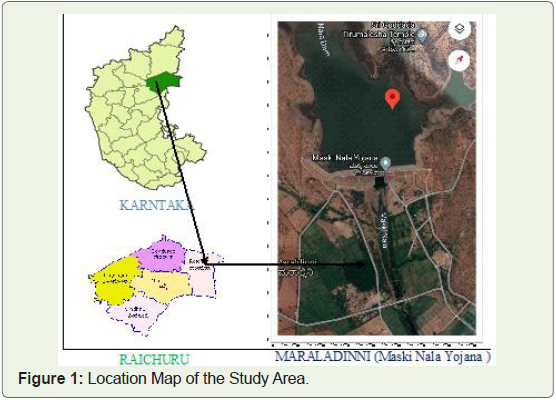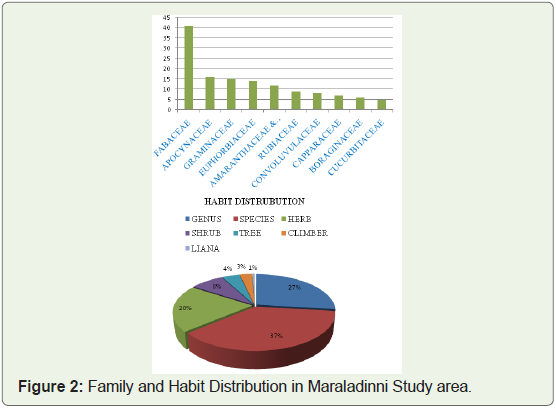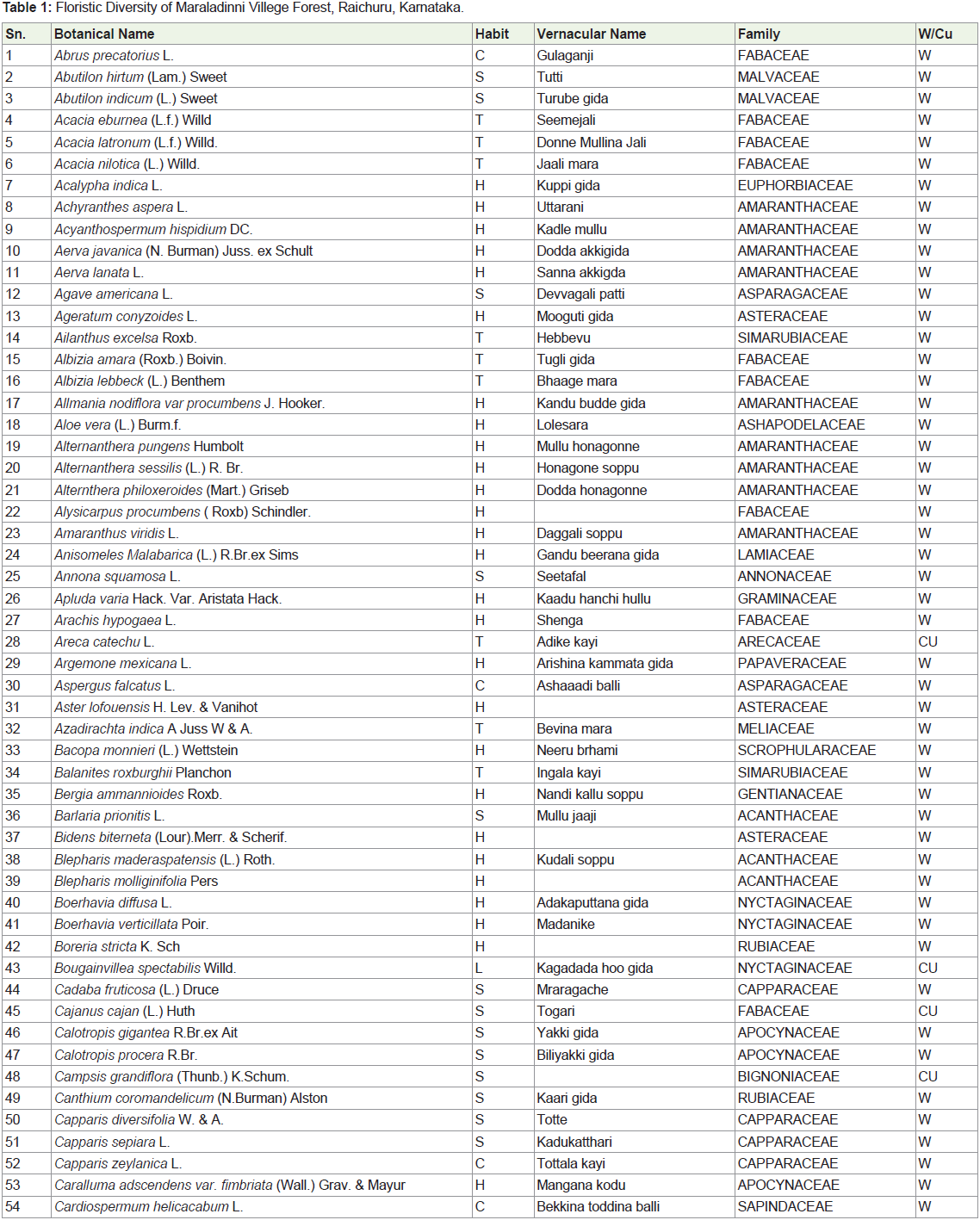Research Article
A Floristic Diversity of Maraladinni Village Forest Raichuru District, Karnataka
Savita and Kotresha*
Taxonomy and Floristic Lab., Department of Botany, Karnatak University’s Karnatak Science College, Dharwad - 580001,
India
*Corresponding author: Kotresha K, Taxonomy and Floristic Lab., Department of Botany, Karnatak University’s
Karnatak Science College, Dharwad - 580001, India; E-mail: kotresh_sk@yahoo.com
Copyright: © Savita R. 2022. This is an open access article distributed under the Creative Commons Attribution License, which
permits unrestricted use, distribution, and reproduction in any medium, provided the original work is properly cited.
Article Information: Submission: 20/03/2022; Accepted: 27/04/2022; Published: 30/04/2022
Abstract
A survey on flora of Maraladinni (Maski Nala Yojana = MNY) was carried out from 2020 to 2021. Maraladinni lies between 16° 00’ 40’’ Latitude North
and 76° 33’ 30’’ Longitude East. The catchment has the total length of the Nala from it’s originates in the Kushtagi taluq of Koppal District and joins the river
Tungabhadra. It is nearly 132.80 Km length. In the present study the survey of floristic diversity reveals about 252 plant species belonging to 186 genera
and 56 families of Angiosperms. In that 29 polypetalae, 16 gamopetalae, 4 monochlamydae and 7 are monocotyledon families. Fabaceae is the top most
family comprises 18 genera and 41 species fallowed by Apocynaceae, 15 genera and 16 species. Poaceae 15 genera and 15 species , Euphorbiaceae
8 genera and 14 species and Amaranthaceae is 9 genera and 12 species, Rubiaceae is 8 genera 9 species, Convoluvulaceae 4 genera 8 species,
Capparaceae 3 genera 7 species, Boraginaceae 3 genera 6 species, Cucurbitaceae 5 genera 5 species respectively. Among the collected plant specimens
26 monocotyledons and 226 were dicotyledons (49 dicotyledons and 7 monocotyledonous families).
Keywords
Floristic diversity; Maraladinni (Maski Nala Yojana)
Introduction
Maraladinni is a village in Lingsugur Taluk. It is located 104 KM
towards west from Raichur District of Karnataka State, India. This
villege is surrounded by Muddebihal Taluk towards West, Shorapur
Taluk towards North, Sindhanur Taluk towards South, Kushtagi
Taluk towards East. The total geographical area of the study area is
974.97 hectares [1-3].
Maskinala dam is situated at Latitude 16° 00’ 40’’ N and Longitude
76° 33’ 30’’ East, in the study area of Maraladinni Maski taluk of
Raichur district. The catchment area of the Maskinala (Maraladinni)
dam site is 800 km2. The catchment has the total length of the nala
from its origin till it joins at the river Tungabhadra is nearly 132.80
Km length. This area lies in the hilly region between Gajendragad,
Kushtagi, Kushtagi and Yalburga an altitude of about 685.80 msl
(mean sea level). Annual mean temperature varies from 63.90°c
(winter) to 103.70°c (Summer) Mean annual precipitation varying from 18 cm to 20 cm (Operation and Maintenance Manual for
Maskinala Dam State of Karnataka, 2019) [4-7].
The maraladinni vegetation type is scrubby with patches of dry
mixed deciduous forest .The present study site falls within the dry
vegetation of Raichuru , in this present work is a sincere attempt to
know the status of vegetation in the maraladinni ( Maski Nala Yojana
=MNY). Till now there is no report has been published regarding this
work so we did an attempt to study of floristic survey in this study
area [8,9].
Materials & Methods
The plant specimens were collected in Maraladinni (Maski Nala
Yojan = MNY) between 2020 and 2021 (fig.1). The collected specimens
were identified with help of flora (Cooke, 1903-1958; Gamble, 1915-
1934; Blatter & Mccann, 1935; Ramaswamy & Raji, 1973; Saldanha
& Nicolson, 1976; Bhandari, 1978; Singh, 1988 Sharma, et al.,1984;
Saldanha,1984-1996; Seetharam et al., 2000; Yadav &Sardeasi, 2002; Prasad & Singh, 2002; Manjunath, et al., 2004; Bhaskara &
Kushalappa, 2014; Kotresha & Sidanand Kambar, 2016; Seetharam et
al., 2018; Yoganarashimhan et al., 2018).
Bentham and Hooker system of classification (1862–1883) was
followed for the arrangement of families. Herbarium specimens were
treated with a solution of 2% of Mercuric Chloride in absolute alcohol
(1000 ml) to control the fungal infections (Ravindranath & Premnath,
1997). The plants will be pressed by dry method (Jain & Rao, 1960).
The specimens were deposited in the Herbarium of Department of
Botany Karnataka Science College Dharwad.
Results & Discussion
The flowering plants were collected and documented from
Maraladinni (MNY) during 2020-2021. The survey reveals about
252 plant species belongs to 56 family and 186 genera. Among
them Fabaceae is the top most family comprises 18 genera and 41
species fallowed by Apocynaceae 15 genera and 16 species, Poaceae
15 genera and 15 species, Euphorbiaceae 8 genera and 14 species,
Amaranthaceae 9 genera and 12 species, Rubiaceae 8 genera 9 species,
Convoluvulaceae 4 genera 8 species, Capparaceae 3 genera 7 species,
Boraginaceae 3 genera 6 species, Cucurbitaceae 5 genera 5 species
respectively (Figure 1). Out of 252 collected plant specimens 26
monocotyledons and 226 are dicotyledons. The study on convention
revealed 151 herbs, 42 shrubs, 25 climbers, 32 Trees and 2 is liana
(Figure 2 & 3).
Whereas 19 plants species are cultivated and 233 plants are
observed in wild. The maximum number of angiosperms species
belongs to dicotyledons.
A large number of studies have been carried out all over the
world on various aspects of floristic diversity. It was conducted in
Karnataka State Women’s University, Jnanashakti, Torvi Campus;
Bijapur reported 257 species under 219 genera and 68 families [14].
Similarly Floristic Diversity of Raichur Fort Karnataka India have
resulted 158 species belonging to 39 families [34] (Table 1).
Reported 133 plant species belonging to 52 families were recorded
from floristic diversity evaluating the role of institutional gardening
in conservation of plant biodiversity; habit wise classification showed
90 species were herbs, 25 trees and 19 shrubs [1].
A total of 152 species representing 131 genera belonging to 55
families have been recorded. Among these, 43 families, 99 genera
and 118 species are dicotyledons. The monocotyledons represent 9
families, 32 genera and 34 species. The study was done that majority
of the plants recorded from the campus area they were mentioned
in Studies on the flora of Mahajana PG campus [25]. A total of 21
plant species belonging to 13 families were mentioned in their paper
work, among them Combretaceae and Fabaceae were the dominant
families, was reported in the paper of “Floristic Analysis of Dabbadka
Reserve Forest, Kodagu, Karnataka, India”[19].
Conclusion
The present investigation shows that Maraladinni (Maski Nala
Yojana = MNY) is rich in herbaceous flora, followed by shrubs,
Trees, climbers and liana respectively. The floristic work composition
indicates that there are 252 plant species belonging to 186 genera and
56 families.
References
7. Gurudeva RM (2001) Botanical and Vernacular Names of South India Plants. Divyachandra Prakashana.
8. Jain SK & Rao RR (1977) Field and Herbarium Methods. Today and Tomorrow’s printers and Publishers.



